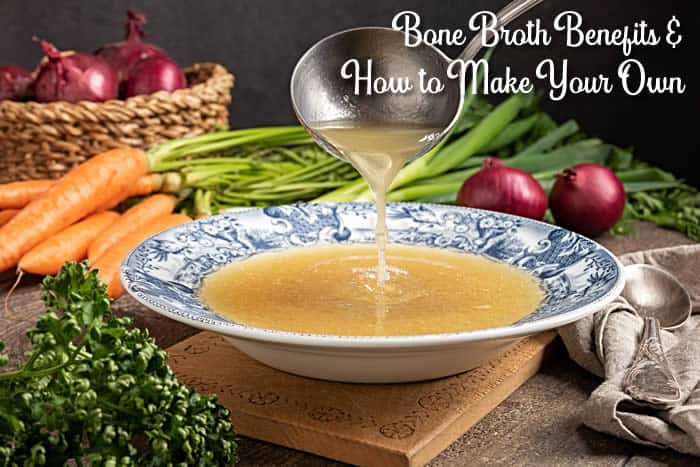
Discover all of the health benefits of drinking bone broth! Some include improved cardiovascular health, healthier skin, hair and nails, and stronger joints. Moreover, find out what the heck bone broth is, what’s in it, and how you can even make your own.

Some of the best health remedies come from natural sources. Herbs and spices are great examples of this. So is bone broth. If you’re not familiar with what bone broth is, we explain that here. We also share a few benefits of incorporating this nutrient-rich liquid into your diet, even providing a bone broth recipe if you feel inspired to make your own.
What Is Bone Broth?
Bone broth is the liquid that’s left after boiling animal bones and connective tissues with a little bit of meat. Some refer to bone broth as stock and use it in recipes for various soups, gravies, and sauces. You can make it from the bones of chickens, cows, turkeys, or almost any other type of animal.
If you’re having a hard time envisioning bone broth, the Food Network refers to it as “chicken soup – minus all the noodles and vegetables.” (1) Not only is it tasty, but you can also use this broth to help boost your health due to the substances it contains.
What’s In Bone Broth?
One of the primary substances found in bone broth is collagen, which accounts for almost one-third of the body’s protein. (2) Collagen is important to the health of your musculoskeletal system, which includes your bones, muscles, tendons, ligaments, and more.
It’s also important to the health of your skin. The skin uses collagen to replace old, dead cells and help new ones grow. Collagen also makes the skin more elastic and stronger. Internally, this protein assists with blot clotting, even giving our organs a protective covering.
Another type of substance found in bone broth is free amino acids (FAAs). In fact, researchers have found 18 different FAAs in broth samples. (3) Free amino acids are amino acids not bound in proteins. According to the American Society for Nutrition, FAAs are absorbed more rapidly and are more readily available than intact proteins. (4)
Bone broth contains minerals as well. If you make bone broth with beef, for instance, a roughly half-cup serving will supply up to 8.5% of your daily value (DV) of calcium, 21.2% of your DV of magnesium, and as much as 12.9% of your DV of iron. (5) And the longer you allow the bones, connective tissues, and meat to simmer, the more minerals will be in the broth. (3)
Research has connected the collagen and amino acids in bone broth with numerous health benefits. Among them are: (6, 7)
- Improved cardiovascular and gut health
- Healthier skin, hair, and nails
- Stronger joints and connective tissues
- Better immune system function
- More effective wound healing
- Relief from diarrhea
How to Make Bone Broth
Making homemade bone broth is easy. Some recipes have you boil the bones for 20 minutes, then drain the water to remove any impurities. Others skip this step and simply have you bring the bones to a boil, then simmer them on low for anywhere from four to 48 hours. (Remember: longer cook time means more minerals in the broth.)
If you add a few tablespoons of apple cider vinegar and juice from a squeezed lemon, this helps draw more collagen from the bones and into the broth. (7) You can also add aromatics for extra flavor, such as garlic, onions, carrots, and celery.

Once you’re done cooking the bones and any aromatics, remove them from the pot and throw them away. Strain the broth, then let it cool. It will stay in the fridge for up to five days, or you can place it in the freezer where it will be good for several months.
If you’re interested in boosting your collagen intake, another option is to take a dietary supplement. Natural Wellness offers Collagen Peptides, which provide 20 grams of hydrolyzed collagen peptides per serving. This product is free from sugar, dairy, wheat, corn, soy, and gluten. It also contains no preservatives or artificial colors or flavors.




